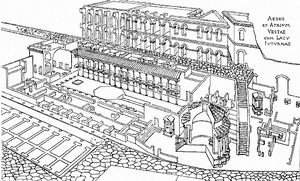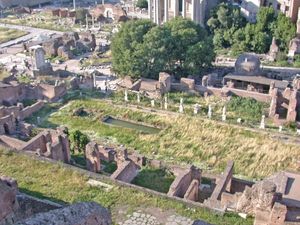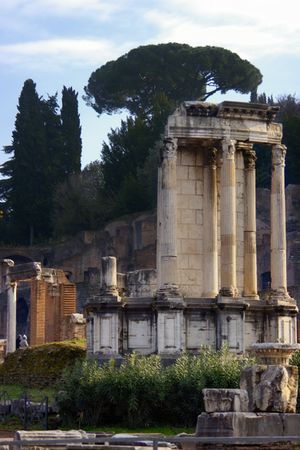عذارى ڤستا

In ancient Rome, the Vestals or Vestal Virgins (Latin: Vestālēs, singular Vestālis [wɛsˈtaːlɪs]) were priestesses of Vesta, goddess of the hearth. The College of the Vestals and its well-being were regarded as fundamental to the continuance and security of Rome. They cultivated the sacred fire that was not allowed to go out. The Vestals were freed of the usual social obligations to marry and bear children and took a 30-year vow of chastity in order to devote themselves to the study and correct observance of state rituals that were forbidden to the colleges of male priests.[1]
التاريخ
قالب:Priesthoods of ancient Rome Livy, Plutarch, and Aulus Gellius attribute the creation of the Vestals as a state-supported priestesshood to king Numa Pompilius, who reigned circa 717–673 BC. According to Livy, Numa introduced the Vestals and assigned them salaries from the public treasury. Livy also says that the priestesshood of Vesta had its origins at Alba Longa.[2] The 2nd century antiquarian Aulus Gellius writes that the first Vestal taken from her parents was led away in hand by Numa. Plutarch attributes the founding of the Temple of Vesta to Numa, who appointed at first two priestesses; Servius Tullius increased the number to four.[3] Ambrose alludes to a seventh in late antiquity.[4] Numa also appointed the pontifex maximus to watch over the Vestals.
The first Vestals, according to Varro, were named Gegania,[5] Veneneia,[6] Canuleia,[7] and Tarpeia.[8] Tarpeia, daughter of Spurius Tarpeius, was portrayed as traitorous in legend.
بنود الخدمة
الاختيار
الواجبات
Their tasks included the maintenance of the fire sacred to Vesta, the goddess of the hearth and home, collecting water from a sacred spring, preparation of food used in rituals and caring for sacred objects in the temple's sanctuary.[9] By maintaining Vesta's sacred fire, from which anyone could receive fire for household use, they functioned as "surrogate housekeepers", in a religious sense, for all of Rome. Their sacred fire was treated, in Imperial times, as the emperor's household fire.
المزايا
العقوبات

بيت الڤستيات

بيت الڤستيات كان منزل كاهنات ڤستا في روما. خلف معبد ڤستا (الذي كان يأوي النار المقدسة)، the Atrium Vestiae was a three-storey building at the foot of the Palatine Hill.
پورتريهات عذارى ڤستا
 Media related to Portraits as vestal at Wikimedia Commons
Media related to Portraits as vestal at Wikimedia Commons
Sieve Portrait of Queen Elizabeth I (1583) بريشة Quentin Metsys the Younger
Vestal Virgin (1677–1730) by Jean Raoux
مدام هنرييت دى فرانس كعذراء ڤستية (1749) بريشة Jean-Marc Nattier
پورتريه لإمرأة كعذراء ڤستية (ع1770) بريشة Angelica Kauffman
المراجع
- ^ For an extensive modern consideration of the Vestals, see Ariadne Staples (1998). From Good Goddess to Vestal Virgins: Sex and Category in Roman Religion. Routledge.
- ^ Livy, Ab urbe condita, 1:20.
- ^ Life of Numa Pompilius 9.5–10 Archived 2012-12-03 at the Wayback Machine.
- ^ Ambrose. "Letter #18". Letter to Emperor Valentianus. Newadvent.org. Archived from the original on 2012-10-22. Retrieved 2012-11-19.
{{cite web}}: Unknown parameter|deadurl=ignored (|url-status=suggested) (help) - ^ English pronunciation: /dʒɪˈɡeɪniə/ ji-GAY-nee-ə
- ^ /ˌvɛnɪˈniːə/ VEN-i-NEE-ə
- ^ /ˌkænjʊˈliːə/ KAN-yuu-LEE-ə
- ^ /tɑːrˈpiːə/ tar-PEE-ə
- ^ "Vestal Virgins". Ultimate Reference Suite. Encyclopædia Britannica. 2003.
للاستزادة
- Beard, Mary, "The Sexual Status of Vestal Virgins," The Journal of Roman Studies, Vol. 70, (1980), pp. 12–27.
- Broughton, T. Robert S., The Magistrates of the Roman Republic, American Philological Association (1952–1986).
- Kroppenberg, Inge, "Law, Religion and Constitution of the Vestal Virgins," Law and Literature, 22, 3, 2010, pp. 418 – 439. [1]
- Peck, Harry Thurston, Harpers Dictionary of Classical Antiquities (1898)
- Parker, Holt N. "Why Were the Vestals Virgins? Or the Chastity of Women and the Safety of the Roman State", American Journal of Philology, Vol. 125, No. 4. (2004), pp. 563–601.
- Samuel Ball Platner and Thomas Ashby, A Topographical Dictionary of Ancient Rome
- Wildfang, Robin Lorsch. Rome's Vestal Virgins. Oxford: Routledge, 2006 (hardcover, ISBN 0-415-39795-2; paperback, ISBN 0-415-39796-0).
وصلات خارجية
- Rodolfo Lanciani (1898) "The Fall of a Vestal" Chapter 6, in Ancient Rome in the Light of Recent Discoveries. Houghton, Mifflin and Company, Boston and New York, 1898.
- article Vestales in Smith's Dictionary of Greek and Roman Antiquities
- House of the Vestal Virgins





